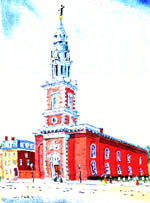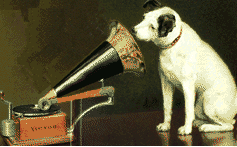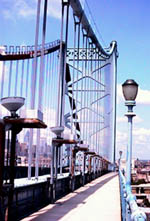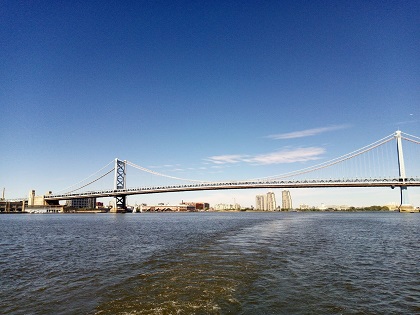

Drive the Bridge
The Benjamin Franklin Bridge
Opened in 1926, Philadelphia's Center City Link to New Jersey
Great cities have great bridges. New York has the Brooklyn Bridge; Venice is a city of beautiful pontes crowned by the Bridge of Sighs. Think San Francisco and you think of the Golden Gate. In Philadelphia, our great span is named in honor of Benjamin Franklin.

Cityscape of Philadelphia from the bridge.
The Benjamin Franklin Bridge started life bearing the prosaic moniker, the Delaware River Port Authority Bridge. After it was finished in 1926 the bridge competed with the energetic ferries that darted across the Delaware, and had done so since William Penn's time. Much like Philadelphia after Benjamin Franklin's arrival in 1724, it took a few years for the populace to get accustomed to the marvel in its midst. It would only be a matter of time before the arcing wonder — then the largest suspension bridge in the world — would supplant those below. In 1956, recognizing the beauty and wonder of the span, it was renamed for Ben Franklin.

The bridge was designed by Paul Philippe Cret, the architect who was also in large part responsible for Philadelphia's Benjamin Franklin Parkway. Driving over the bridge and passing under its two tall towers connected by tapering cables, puts one in mind of Dorothy entering into Kingdom of Oz — there is a fearful exhilaration. This bridge does not merely span the Delaware — it soars over the river. Painted a resonant blue, at some points the bridge seems to merge with the sky.

By evening, the bridge dances to a different beat. Gone are the restless drumbeats of commuting tires. Whereas the bridge takes on a blue-overalls-go-to-work aspect during the day, the Ben is ready to rumba by night. Thanks to a computer-driven lighting system added for the Bicentennial, the span actually appears to shimmy — for trains passing over the bridge trigger sensors which illuminate each cable in succession. The cables resemble piano keys, and as strong beams of light briefly alight on each cable in a cascading crescendo, the bridge dances rhapsodic.
The Benjamin Franklin springs from the venerable Phialadelphia neighborhood called Olde City. Two historic churches, St. Augustine and St. George's, are nestled at the base of the bridge. St. George's, which dates to 1769 and is the oldest Methodist church in the United States, was originally in the way of where the bridge's engineers intended to place the span. Said engineers were forced into court however, to change their design so as to allow the threatened church 14 feet of breathing room.

St. Augustine's Church
St. Augustine's, which dates to 1796, is the oldest Augustinian church in Philadelphia. Among the original subscribers to the church was "saucy" John Barry, a Revolutionary War naval hero and then commodore who also has an elegant bridge named for him down the road in South Jersey. Church membership had dwindled over the years, with many congregants taking a one-way trip over the Ben to the greener vistas of New Jersey. As money became tight, the church could not even afford to maintain the lovely mid-19th-century artwork and frescos painted on its ceiling.
Then in 1992, the church's steeple blew off during a brutal December storm and fell onto the Benjamin Franklin Bridge, closing the span for three days. Miraculously, no one was hurt, but a fifty-foot chasm opened in the church's ceiling and many paintings and murals suffered water damage. In the church's insurance policy, however, the destruction of the steeple and the damaged artwork were considered Acts of God. St. Augustine's used the settlement to repair the steeple and preserve the damaged paintings. Talk about mysterious ways.

Nipper, the RCA dog
Our bridge connects us to Camden, the onetime home to Walt Whitman, RCA's Nipper, and still currently home to Campbell Soup. It's no secret that Camden has fallen on hard times. But there is a chiseled quote from Whitman that circles the top of Camden's City Hall which reads, "I dreamed I saw a city invincible." The quote is wholly appropriate for Camden. This timeworn city is much like a boxer taking a standing eight — dazed but ready to fight again. Preservationists have lovingly repaired the stained-glass Nipper that vandals had desecrated with rocks. An aquarium built on the eastern bank of the Delaware is topped by a dome which at night turns different colors to reflect the weather. Many nights it glows bright red — clear weather ahead.

New Jersey itself feels like a family member to many Philadelphians, a cherished country cousin whom we enjoy visiting. Awaiting us in the Garden State are the things we love and embrace as our own: diners, roadside fruitstands, and best of all, the Jersey shore, where we spend our halcyon sun-drenched summer weekends that seem almost beyond the reach of time.
But return we must, and upon returning home from the shore, tired and sun-happy on Sunday night, it is the Ben Bridge that lets us know we are home. Driving across the blue arc, we see the red-orange blazing neon letters of the PSFS sign, once the largest neon in the world. We see the rest of our beloved skyline, the maligned grandeur that is City Hall with a yellowish, Londonlike pallor emanating from its clock. It is our familiar, comforting vista that says, "We're home and ready to be tucked in.

Bridge statistics
- Total length of bridge: 9,650 feet
- Length of main span: 1,750
- Width of bridge: 128 feet
- Width of roadway: 57 feet
- Height of towers: 380 feet
- Clearance above mean high water: 135 feet
- Diameter of cables: 30 inches
- Number of wires in each cable: 18,666
- Ultimate strength of cables: 125,000 tons
- Weight main span per linear foot: 26,000 pounds
- Live load capacity per linear foot: 12,000 pounds
- Weight of steel towers: 10,000 tons
- Cables and suspenders: 7,350 tons
- Suspended spans: 18600 tons
- Anchors: 6,000 tons
- Approaches: 25,800 tons
Masonry
- Main piers: 60,000 cubic yards
- Anchorages: 216,000 cubic yards
- Approaches: 42,000 cubic yards
- Total weight of bridge: 720,000 tons
- Deepest foundation below mean high water: 105 feet
The commissioners of the Delaware Port Authority dedicate this bridge to the memory of a great patriot, scientist and statesman and his honor name it name it the Benjamin Franklin Bridge January 17, 1956.
The Delaware River Bridge Joint Commission authorized by Act of the New Jersey Legislature, April 8, 1919, and by Act of the Pennsylvania legislature July 9, 1919, to build this bridge over the Delaware River between Philadelphia and Camden. The cost of construction shared by Commonwealth of Pennsylvania, the state of New Jersey and city of Philadelphia organized December 12, 1919. Began construction, January 6, 1922 and opened the bridge with ceremonies on July 1, 1926.
Board of Engineers
- Chief Engineer: Ralph Modjeski
- George S. Webster
- Laurence A. Ball
- Supervising Architect: Paul P. Cret
- Assistant Engineers: Clement E. Chase, Leon Moisseiff and Montgomery B. Case




